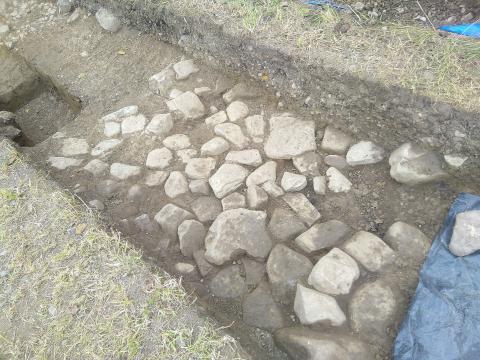Our Roman Road

The archaeology proved me wrong.
We have known for some time that there was a Roman road very close to our chapel. The Ordnance Survey and the straightness of Long Lover Lane, coupled with the right-of-way which continues into the field, convinced me that the tarmacked lane by which our chapel stands marked the Romans’ road. In the last week or so, researchers have been digging in the field to our rear, and lo, they found a layer of stones, which is likely the surviving rubble foundation, such as those 1st Century engineers were used to employ.

Following the lie of the land, one can just discern some of the accompanying ditches into which the surface water would have drained (above). So though I have been proved wrong (an experience with which I have become increasingly familiar in my forty-odd years’ existence), I am delighted to now know with certainty that the sons of Daniel’s Fourth Beast were busy in our environs. It is remarkable, is it not, that Roman legionaries were active within 150 yards of our chapel only four decades after Christ’s death and resurrection. In the very years that the legions besieged and devasted Jerusalem as the Lord prophesied, they would be digging and measuring at Martin Top.
The man who ordered this road programme was Vespasian, who had initially been Nero’s general at Jerusalem, but was proclaimed emperor himself before the siege was concluded. This road network was designed to civilise wild Britannia, and allow for easy military deployments between the local forts at Ribchester, Elslack and Ilkley. For the best part of three hundred years, legionaries, cavalrymen, optios and centurions travelled up and down that road. In addition, traders, merchants, slave dealers and, dare I say, Christians, slapped their sandals against those stones. Those early Christ followers, some of whom might have remembered the apostles themselves, would have thought our hills a dangerous and wild place, somewhere to hurry past, afore bandits or uncivilised natives made their presence felt. Yet two millennia later, and the Lord still has a people in these parts. Our language, clothes and customs would be foreign to those Roman brethren, but our doctrines, practices and devotion to the Galilean they would recognise and celebrate.
Read about the straight road to heaven, here.


- Log in to post comments


 Sunday Worship 10.45am & 6.00pm
Sunday Worship 10.45am & 6.00pm